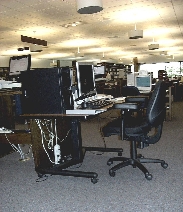|
|
Accessibility & Technology
|
| |
Audrey Gorman's mid-2003 answer to a typical question on the AXSLIB-L Internet discussion list, which is provided by EASI:
|
| |
Hi Meg,
I agree with Valerie that the Microsoft Accessibility tools are insufficient for people with disabilities. I do think that they're good in a pinch and to show people that accessibility is a concept that has been embraced by the corporate world. Add IBM and Hewlett-Packard, who have had commitments for quite some time, to the list of such corporations. There are lots more. This takes the discussion of accessibility from one of "compliance with the law" or "a nice thing to do" to one of "it's a good business decision and it brings business in."
|
| |
I'm concerned that there's nothing in your message of the wide range of flexible software that inhabits the gaping chasm between Microsoft Accessibility Options and JAWS. Of the 54 million people with disabilities (or is it 63 million now?), only about 1 million or so can make good use of JAWS: blind people who know JAWS. Not even all blind people know JAWS. Some people note that the software requires concentration and determination if one is to become proficient, and not everyone wants to put in the time. (I don't know personally. I'm not blind and have never learned it, though I know a number of people who do.) It's not particularly user-friendly or easy to learn.
|
| |
There's also the issue of library staff comfort with JAWS. Many librarians confronted with it have had problems because they don't learn it well enough to be helpful to library users, so it tends to sit unused except where there's a concentration of blind people who already know it. JAWS is not something your average reference or children's staff members are going to use willingly or comfortably. And having only one or two people on the staff able to use your accessibility solutions doesn't serve people with disabilities equitably or consistently.
|
| |
Trying to solve accessibility with JAWS as the cornerstone leaves most of the rest of us out, especially those with learning disabilities (LD). People with specific learning disabilities, including dyslexias, dyscalculia, and dysgraphia, are the largest sub-group of people with disabilities (PWDs, for short). Then there are those with visual impairments, carpel tunnel syndrome and other repetitive stress injuries, speech and language impairments, people who use wheelchairs and scooters, and so on. The other 53(62?) million of us.
|
| |
I'd start with ZoomText Xtra and one of the packages designed for people with LD, plus a simpler tool for people who are blind. Take a look at my web site at http://www.accessall.net and read about the AccessInfo System. We've based it on the principles of universal design and universal access.
|
| |
Good luck with providing access to your community. It's great to see more libraries actively welcoming people with disabilities along with the rest of the community.
|
| |
Please contact me if you have questions about my approach.
|

|
AccessInfo System, Naperville (IL) Public Library March-May 2003
|
Keyboards
|
|
|











